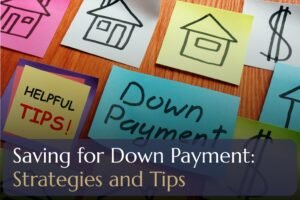Introduction
Planning to purchase a home in India? It’s exciting but comes with a fair share of financial planning. One of the biggest hurdles? The down payment. Banks can fund 75-90% of your property, sure, but the remaining amount is your responsibility. And it’s not merely about money—you require strategy, self-control, and familiarity with the right tools and schemes to achieve this.”.
Let’s make your journey easier with real tips and strategies to save wisely for your home’s down payment.
Understanding Down Payments
What is a Down Payment?
A down payment is the amount of money you pay upfront while buying a house, with the rest financed with a home loan. This is usually between 10-25% of the property’s value.
Typical Down Payment Requirements in India
In India, the Reserve Bank of India (RBI) requires that banks can provide finance for 80-90% of the cost of the home, depending on the loan value. You must pay the remaining amount, such as registration fees, GST, and miscellaneous expenses.
Factors Affecting Down Payment Amount
- Value of property
- Property type (under-construction vs ready-to-move)
- Bank’s LTV (Loan to Value) ratio
- Your credit report and current liabilities
Why Start Early?
Power of Compounding of Early Savings
Time is your friend if you save. The earlier you start, the more you gain from compounding—particularly if you invest in SIPs or recurring deposits.
Psychological Readiness
As you start saving early, you not only build your wallet but also prepare your mind for becoming a homeowner—a massive life choice.
Budgeting and Financial Planning to save for down payment
Track Your Expenses: Take the help of Excel, Google Sheets, or budgeting apps like Walnut, Monefy, or Good budget to note down each rupee you spend.
Set a Realistic Savings Target: Determine how much you require, set a timeframe (e.g., 3-5 years), and divide it into monthly savings goals.
Utilize Budgeting Apps/Tools: Use apps such as Money Manager or ETMONEY to categorize spending and identify saving opportunities.
Smart Saving Strategies
Open a Separate Savings Account: Save your home savings in a separate account so you’re not tempted to spend it.
Automate Your Savings: Auto-transfer schedules after salary credit. Pay yourself first, so to speak, before the bills.
Windfall Savings & Bonuses: Tax refunds, Diwali bonuses, or presents—direct all unexpected money into savings.
Down Payment Investment Options
SIPs (Systematic Investment Plans): Begin with just ₹500/month. In 5 years, SIPs in balanced mutual funds can earn big returns because of compounding.
Recurring & Fixed Deposits: Perfect for conservative investors. Provides fixed interest with little risk. Apply them to short-term objectives in 1-3 years.
Liquid Mutual Funds: For extremely short-term objectives (6 months–1 year), liquid funds are a superior option to savings accounts with better returns and instant liquidity.
Reduce Unnecessary Spending
Find Non-Essential Expenses: Uber Eats, monthly subscriptions, or fancy coffee—it adds up quickly. Trim the fluff, not the fun.
Lifestyle Changes That Have a Big Impact: Look at carpooling, home cooking, or forgoing luxury shopping sprees. It’s temporary sacrifices for long-term rewards.
Government Schemes to Help Home Buyers
Pradhan Mantri Awas Yojana (PMAY): Provides interest subsidy under CLSS (Credit Linked Subsidy Scheme) for first-time home buyers of EWS, LIG, and MIG categories.
CLSS Benefits
- Interest rate subsidies between 3-6.5%
- Drastic reduction in EMI burden
State-Level Housing Assistance: States such as Tamil Nadu and Maharashtra also operate schemes encouraging urban homeownership—check local government websites.
Search for Affordable Housing
Search Outside Metros: Tier-II and Tier-III cities such as Nashik, Haldwani, Mohali, or Lucknow have more reasonably priced property rates with high growth prospects.
Under-Construction Properties: Typically less expensive than ready-to-move-in properties. Search for RERA-registered builders for safety.
How to Opt for the Right Home Loan Scheme
Compare Lenders: Utilize aggregator websites such as BankBazaar or PaisaBazaar to compare home loan proposals, EMIs, and eligibility.
Understand Interest Rates & EMIs: Opt for fixed or floating rates depending on your financial solidity.
Assess Processing Fees and Concealed Charges: Look for legal charges, documentation fees, and foreclosure fees prior to committing yourself.
Reflect on Joint Home Loans
Eligibility and Advantages: Applying with a spouse or parent enhances your loan eligibility and distributes the financial load.
Tax Benefits: Both the applicants can claim tax deductions under Section 80C and 24(b) on principal and interest payments.
Financial Discipline and Accountability
Make a Financial Checklist: Follow savings progress, due dates, and goal milestones on a monthly or quarterly basis.
Use Accountability Partners: A spouse, sibling, or financial advisor can assist you in staying on track through periodic check-ins.
Side Hustles to Boost Income
Freelancing and Gig Economy: Utilize platforms such as Upwork, Freelancer, or even online teaching on Vedantu or Unacademy to increase savings.
Monetize Hobbies or Skills: Do you enjoy baking or photography? Get them turned into weekend gigs. Every additional rupee saved matters.
Learning from Actual Experiences
Case Study: Arjun’s Pune Home: Arjun, a software employee, saved ₹10,000/month through SIPs and reduced entertainment outgo. In 5 years, he accumulated a down payment of ₹6 lakhs!
Frequent Errors to Steer Clear Of
- Waiting too long to save
- Underestimating additional fees (stamp duty, GST)
- Dependence solely on employer bonuses
Role Played by Real Estate Builders Like Tata Housing
Loan Process Support: Tata Housing appoints a personal agent to walk you through the home loan process.
Dedicated Agents for Home Buyers: From site visits to possession, their customer support makes your first home buying experience stress-free.
Conclusion
Buying your first home is one of life’s biggest dreams—and saving for the down payment is your first victory. By following these strategic, simple, and consistent steps, you’ll not only reach your goal but also be financially empowered throughout the journey.
Remember—discipline conquers luck, and tiny efforts today construct your dream house tomorrow.
FAQs
1. How much do I need to save as a down payment in India?
Typically, aim to save 20% of the property’s cost, plus an additional 5-7% for registration and miscellaneous expenses.
2. Can I pay a down payment using a personal loan?
It’s not recommended. Lenders consider this to be risky and can turn down your home loan proposal if you use a personal loan to fund the down payment.
3. What are the best investment avenues for short-term saving?
SIPs in hybrid mutual funds, fixed deposits, recurring deposits, and liquid funds are good alternatives based on how soon you need the money.
4. Does a larger down payment lower EMI?
Yes, the larger down payment lessens the loan amount, interest outgo, and EMI burden substantially.
5. Am I eligible for tax benefits on the down payment?
No. Tax benefits under Section 80C and 24(b) are only after loan disbursal—not on the down payment.





